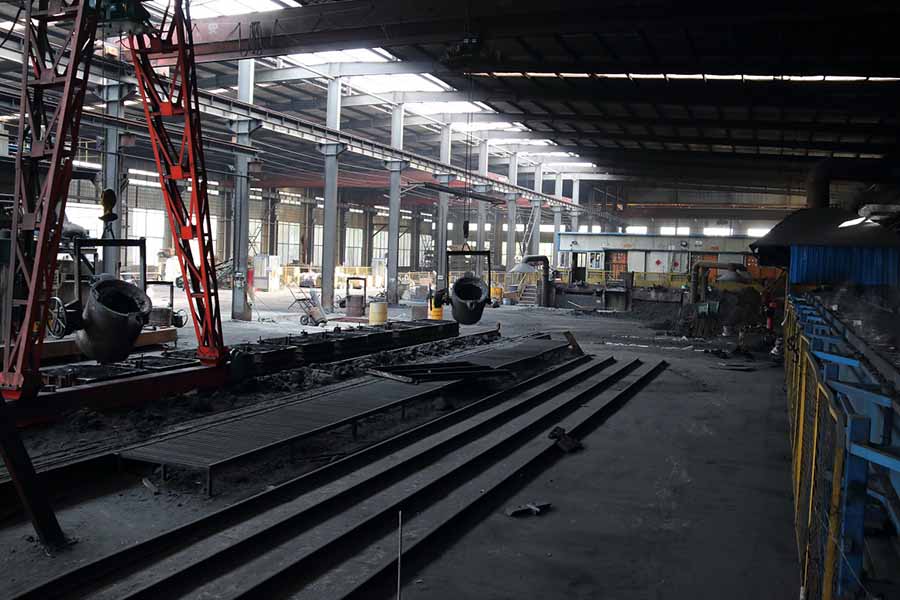| Casting Capabilities for at RMC Foundry | ||||||
| Casting Process | Annual Capacity / Tons | Main Materials | Casting Weight | Dimensional Tolerance Grade (ISO 8062) | Heat Treatment | |
| Green Sand Casting | 6000 | Gray Cast Iron, Ductile Cast Iron, Cast Al, Brass, Cast Steel, Stainless Steel | 0.3 kg to 200 kg | CT11~CT14 | Normalization, Quenching, Tempering, Annealing, Carburization | |
| Resin Coated Sand Casting (Shell Casting) | 0.66 lbs to 440 lbs | CT8~CT12 | ||||
| Lost Wax Investment Casting | Water Glass Casting | 3000 | Stainless Steel, Carbon Steel, Alloy Steel, Brass, Aluminium, Duplex Stainless Steel, Cast Iron | 0.1 kg to 50 kg | CT5~CT9 | |
| 0.22 lbs to 110 lbs | ||||||
| Silica Sol Casting | 1000 | 0.05 kg to 50 kg | CT4~CT6 | |||
| 0.11 lbs to 110 lbs | ||||||
| Lost Foam Casting | 4000 | Gray Iron, Ductile Iron, Alloy, Carbon Steel, Stainless Steel, Brass, Al | 10 kg to 300 kg | CT8~CT12 | ||
| 22 lbs to 660 lbs | ||||||
| Vacuum Casting | 3000 | Gray Iron, Ductile Iron, Alloy Steel, Carbon Steel, Stainless Steel | 10 kg to 300 kg | CT8~CT12 | ||
| 22 lbs to 660 lbs | ||||||
| High Pressure Die Casting | 500 | Aluminium Alloys, Zinc Alloys | 0.1 kg to 50 kg | CT4~CT7 | ||
| 0.22 lbs to 110 lbs | ||||||
Special casting is relative to sand casting, and it has also been used more and more widely. In actual casting production, the commonly used special casting methods include investment casting, plaster casting, ceramic casting, lost foam casting, metal die casting, high pressure casting, low pressure casting, differential pressure casting, vacuum suction casting, adjustable pressure casting, Squeeze casting, centrifugal casting, continuous casting, V method casting, graphite casting shell casting, electroslag casting, ... etc.
Compared with conventional sand casting, the difference between special casting and sand casting can be summarized as follows:
1. Different Patterns
The patterns used in sand casting are wooden or metal molds, which must be taken out after modeling, so the casting molds are two or more boxes. Investment casting and partial plaster casting use fusible (wax) molds that are easy to melt, while lost foam casting uses foamed plastic molds, which can be lost by molten metal during casting. Therefore, the casting molds of these methods are all made into a whole, without opening the box to start the mold, thereby improving the dimensional accuracy of the casting.
2. Different casting materials and manufacturing processes
Investment casting, gypsum mold casting, and ceramic mold casting use ceramic slurry and gypsum slurry as mold materials, respectively. The molds produced have higher dimensional accuracy and lower surface roughness than sand molds. Of course, their manufacturing processes are also different. For example, investment casting is to make a thin shell mold by applying paint, sanding, and drying on the fusible (wax) module. The other type of casting material is metal materials, such as metal casting, pressure casting, squeeze casting, etc., which use metal castings, whose dimensions are more accurate than sand molds, and can be cast in one mold.
3. Special casting improves liquid metal filling mold and subsequent condensation conditions
In some special casting methods, the molten metal is filled and solidified under the action of centrifugal force (centrifugal casting) or pressure (pressure casting, low pressure casting, differential pressure casting, squeeze casting, etc.), so the casting quality is good. Another example is metal mold casting, although the mold is still filled under gravity, but the metal mold accelerates the cooling rate of the casting, refines the crystal grain of the obtained casting, and improves the mechanical properties. Because special casting methods such as centrifugal casting and squeeze casting complete the filling and solidification under relatively high pressure, it is beneficial to reduce or eliminate the shrinkage and porosity of the casting. During solidification, the casting cools quickly, the crystal is refined, and the structure is dense. The mechanical properties of some special castings can be comparable to forgings.
The above three characteristics are not available in every special casting method. Some special casting methods may only have one or two characteristics, and some special casting may have three characteristics at the same time.
The Automatic Mordern Advanced Sand Casting Iron Foundry at RMC:

 русский
русский



